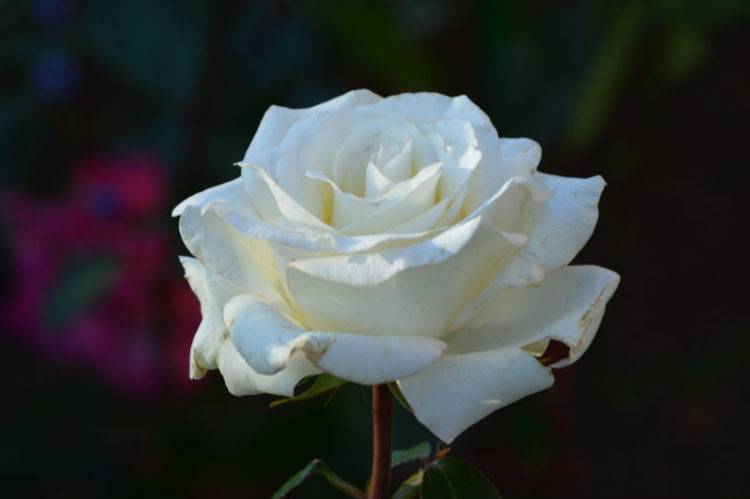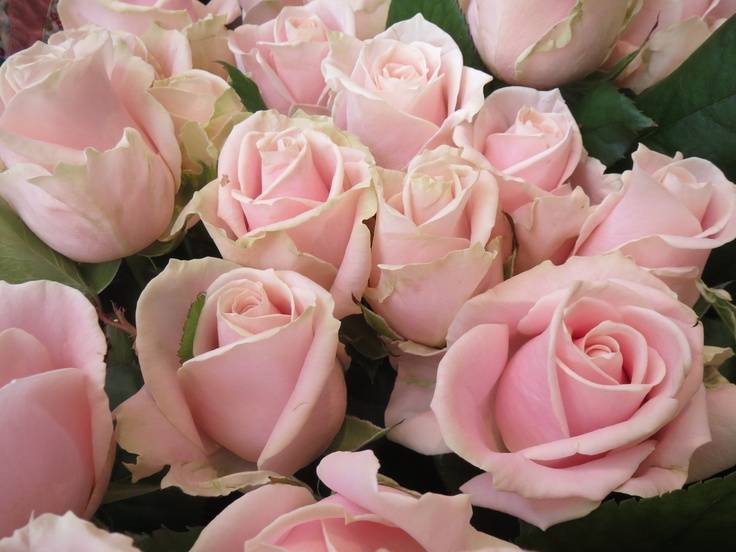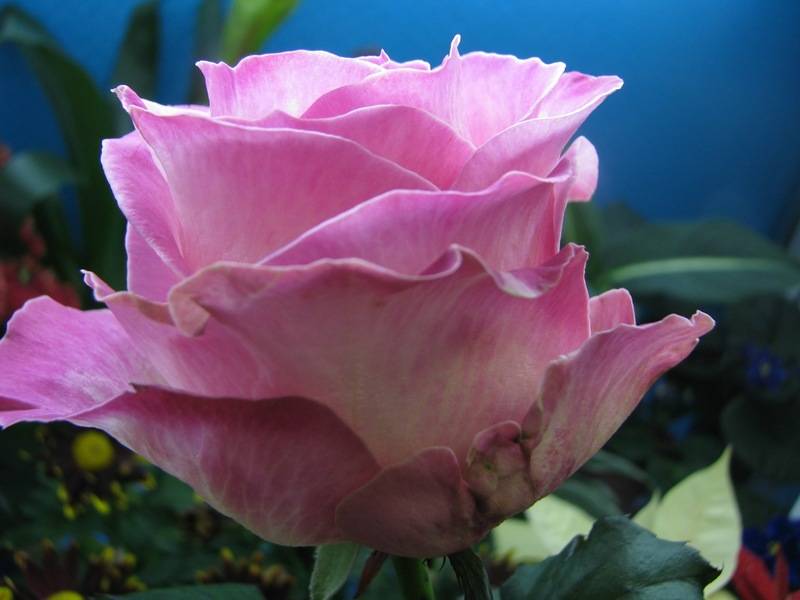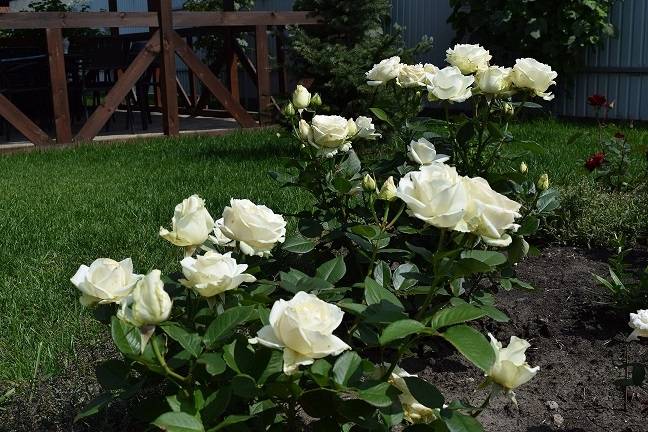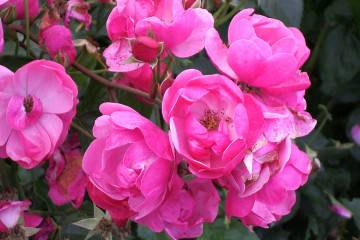Rose Avalanche
Content:
Avalange Snow White Hybrid Tea Rose is a true classic. Its bud has the most attractive and noble shape, and the aroma only reinforces the stunning impression.
Rose Avalanche
Translated from Latin, "avalanche" means "avalanche". This indicates that the variety blooms throughout the warm season without interruption. Bred in Holland by breeder Lex Voorn in 2004. In the catalogs the variety is codenamed Lexani. It is based on a white tea variety and a remontant tea variety.
The bush is compact, 80-120 cm high, up to 70 cm wide. The shoots are directed vertically upward, each ending in one bud. There are few thorns. The leaves are dark green, glossy. The petals are white (shade - pearl), with a light emerald undertone, there are 40-50 of them in the corolla. The flower is terry, up to 10-13 cm in diameter, after opening it takes on a cupped shape.
Advantages and disadvantages of the variety
Avalange rose has many advantages:
- Pleasant smell and attractive appearance of flowers.
- Resistance to diseases and pests.
- Long flowering period: from June until the first frost.
- Cut flowers last up to 2 weeks.
- Resistant to sun fading.
- Frost resistance - up to -23 ° С.
Of the shortcomings, gardeners note the exactingness of care.
Use in landscape design
Rose Avalange looks attractive in a solo fit. Nearby, it is recommended to plant low-growing annuals or ground covers with shallow roots. In landscaping, hybrid tea roses are often planted surrounded by green lawns or gravel.
Varieties of this variety
After the Avalanche variety was obtained by selection, several of its varieties were subsequently bred. Those that deserve special attention are presented below.
Rose Sweet Avalanche
The description says that this flower has buds as large as those of the ancestor - up to 10 cm in diameter, but the petals are painted in a pale pink shade.
Breeding work was carried out in England. The aroma is more intense, intensifying in the evening. It is grown mainly for cutting in greenhouses, so it is very rare to find it in flower beds.
Candy Avalanche
Candy is bred to produce fabulously beautiful bouquets. The buds of a pale pink color with a milky undertone perfectly keep their shape, for a very long time and gradually opening.
Corolla diameter - about 8-10 cm. Delicate fruity aroma. In the cut, it costs up to 12 days.
These are not the only varieties that breeders managed to bring out. On sale you can also find Pink Avalange rose and others.
Growing a flower
Seedlings must be purchased from specialized nurseries. The variety is quite new, so it is still difficult to find its original planting material in the widest sale.
In what form is the landing
Tea hybrids do not propagate by seeds.100% of varietal traits is carried only by a vegetatively obtained seedling.
Vaccination is done on frost-resistant 3-year-old rosehip bushes. You can buy a copy with an open or closed root system. The second option is preferable, since it increases the chances of survival and does not limit the timing of planting in open ground.
What time is the boarding
The right moment comes in the spring in May, or early in the fall.
- Spring planting is carried out after warming up the soil to +12 ° С. Because recurrent frosts are detrimental to young bushes.
- In autumn they are planted at the end of September, leaving at least 3 weeks until frost to give the rose enough time to root.
Location selection
The site is selected sunny, but with shelter from the prevailing and northerly wind direction. A gusty wind can spoil the flowers and the appearance of the bush, reducing work with it to zero.
Partial shade for tea hybrids is undesirable, since with a lack of lighting, the flowers become smaller.
How to prepare the soil and flower for planting
The optimum depth of the planting pit is about 50 cm. Dig it in advance. A minimum of 70 cm is left between the pits.
Organic matter is poured at the bottom: humus, peat, compost, and then watered abundantly, giving time for nutrients to saturate the soil. Then a small layer of drainage is poured from a mixture of sand with fine gravel.
Planting material in containers does not need such preparation.
Planting procedure step by step
The sequence of work is as follows:
- A fertile soil mixture is prepared: a little sand and 50 g of superphosphate are additionally added to the soil for roses.
- The roots are lowered into the hole, deepening the root collar by 3 cm.
- The roots are covered with a fertile soil mixture.
- Water abundantly.
- Mulch.
Plant care
All the activities that need to be carried out with a rose during the season do not fundamentally differ from the care of other tea hybrids.
Watering rules and humidity
Watering is carried out as soon as the topsoil dries up. It is important to maintain a balance, not forcing the bush to suffer from drought, but also without waterlogging the soil.
Cold water can stress the roots, so it is allowed to stand in the fresh air so that it becomes the same temperature as the environment. Consumption per bush - up to 20 liters. The regularity depends on the weather, but at least 2 times a week in the summer. In the fall, watering must be stopped completely.
Top dressing and soil quality
In May, nitrogen fertilizers are applied under the bushes. In summer, potassium-phosphorus supplements are needed.
Humus and vermicompost can be fertilized at any time, observing an interval of at least 3 weeks.
Pruning and replanting
The end of October is the best time for autumn pruning. Leaves and all unripe buds, weak shoots are removed. The next time the pruning is done in the spring. Frostbite, broken branches are cut out.
Shrubs are transplanted in early spring or in September. As a last resort, you can do this work in the summer, then choose a cloudy day, and shade the bush in a new place in the first days. Before transplanting, you need to cut off all the buds and shorten the stems. The bush is dug in a circle, retreating from the root collar by 50 cm in all directions.
Features of wintering a flower
Although the frost resistance of Avalange reaches -30 ° C, in order to preserve the attractive appearance of the bush in the Middle Lane, it is recommended to cover it for the winter.
To do this, a layer of fertile soil is poured around the roots, 30 cm in each direction. After pruning, the bush is covered with agrotextile and fixed so that it is not blown away by the wind. The shelter is removed in the second half of April.
Blooming rose
Avalange is a white rose with long and even flowering.There will be no breaks with proper farming throughout the season.
The first buds appear at the end of May, and bloom with the arrival of summer. Flowering ends before frost, but the last buds should be cut off so as not to deplete the plant before a long winter.
All summer long it is necessary to take care of the bushes: water, feed, loosen the soil at the roots. Withered buds are cut off in time, as are leaves with suspicious spots.
What if it doesn't bloom? During the first summer, the bush may not bud. This is not abnormal. If there are no flowers in the second year, then it is necessary to transplant to a more illuminated place. To stimulate the forcing of new buds, it is imperative to cut off the old ones, carry out top dressing, and every 3 years it is imperative to carry out a radical rejuvenating pruning.
Flower propagation
Planting material (cuttings) is cut from bushes over 3 years old. Only healthy roses that do not have traces of fungal diseases and pests are suitable.
The right time to get cuttings is spring, when sanitary pruning is carried out. At this time, you can cut the shoots for distillation. The second option is at the beginning of June, when the leaves have already grown, and the first buds have blossomed.
A stalk 10-12 cm long must be cut at an angle of 45 °. The apex is cut at right angles. The leaves are cut in half. The lower end should be kept in a growth stimulant solution for about an hour. Then they drop it 2-3 cm into the soil in a garden bed or in a flower pot. Be sure to cover the top with a transparent cap (cut plastic bottle, glass jar, bag, etc.). In this greenhouse, seedlings need to remain:
- Until spring, if planted in a pot. Then they are transplanted into open ground.
- Until mid-September when planting in the garden. Then they are transplanted to a permanent place and necessarily build a shelter for the winter.
Diseases, pests and ways to control them
Black spot and powdery mildew can affect rose leaves in cold and damp weather. It is imperative to take preventive measures: in the spring, 2-3 times with an interval of 7 days, spraying with Bordeaux liquid is carried out. This measure will also help against other diseases: rust, gray mold.
Rose Avalange is a delicate and very beautiful perennial plant, the beauty of which is worth the effort spent on care. Gardeners consistently favor the delicate simplicity of white tea hybrids.

